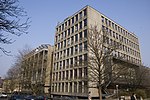BBC Studios Natural History Unit
The BBC Studios Natural History Unit (NHU) is a department of BBC Studios that produces television, radio and online content with a natural history or wildlife theme. It is best known for its highly regarded nature documentaries, including The Blue Planet and Planet Earth, and has a long association with David Attenborough's authored documentaries, starting with 1979's Life on Earth. The Natural History Unit is a specialist department within BBC Studios Productions. Each year it produces around 100 hours of television and 50 hours of radio programmes, making it the largest wildlife documentary production house in the world. The BBC commissions programmes from the Unit for broadcast on five terrestrial television channels (BBC One, BBC Two, BBC Four, CBBC and CBeebies) and BBC Radio 4. It also makes programmes for other broadcasters and services including Apple TV+, Warner Bros. Discovery, National Geographic Global Networks and NBC Universal. Content is marketed internationally under the BBC Earth brand. Original content is also broadcast on the Earth Unplugged YouTube channel.The Unit has been based in Broadcasting House, Bristol since its formation in 1957, and has been headed by Julian Hector since 2016.
Excerpt from the Wikipedia article BBC Studios Natural History Unit (License: CC BY-SA 3.0, Authors).BBC Studios Natural History Unit
Whiteladies Road, Bristol Cotham
Geographical coordinates (GPS) Address Nearby Places Show on map
Geographical coordinates (GPS)
| Latitude | Longitude |
|---|---|
| N 51.461006 ° | E -2.608005 ° |
Address
BBC
Whiteladies Road 23
BS8 2LR Bristol, Cotham
England, United Kingdom
Open on Google Maps








